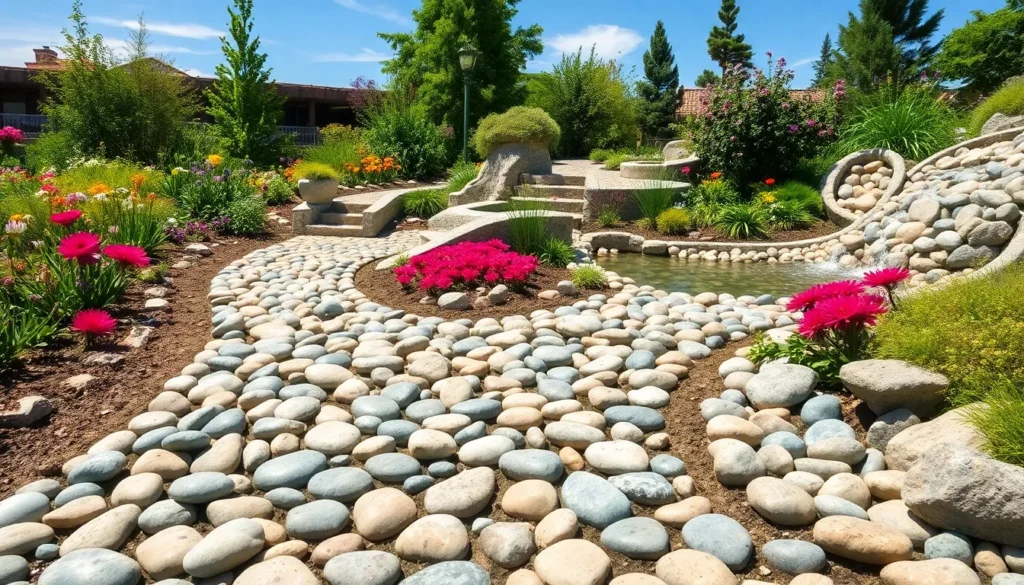Garden pebbles can transform any outdoor space from ordinary to extraordinary with minimal effort and maximum impact. We’ve discovered that these versatile stones offer endless possibilities for creating stunning landscapes that require virtually no maintenance while adding texture, color, and visual interest to your garden.
Whether you’re dealing with problem areas where grass won’t grow or simply want to elevate your garden’s aesthetic appeal, pebbles provide the perfect solution. From creating elegant pathways and defining plant borders to designing zen-inspired meditation spaces, these natural elements work beautifully in both contemporary and traditional garden designs.
We’ll share creative ideas that’ll help you harness the full potential of garden pebbles, showing you how to use different sizes, colors, and arrangements to achieve professional-looking results on any budget. Get ready to discover simple yet impressive ways to make your garden the envy of the neighborhood.
Create Stunning Pathways With Decorative Pebble Walkways
Pebble walkways transform ordinary garden spaces into inviting outdoor corridors that guide visitors through your industry design. These pathways offer both functionality and visual appeal while requiring minimal upkeep compared to traditional paved surfaces.
Choose River Rock for Natural Appeal
River rock creates the most authentic looking pathways that blend seamlessly with existing garden features. We recommend selecting stones between 1 to 3 inches in diameter for optimal walking comfort and visual impact. Smooth river rocks in neutral tones like gray, beige, and brown provide timeless appeal that complements any garden style.
Installing river rock pathways requires a 2 to 3 inch excavation depth to ensure proper drainage and stability. Creating defined edges using metal or plastic borders prevents the stones from spreading into surrounding garden beds. Natural variations in size and color add organic texture that mimics dried riverbeds found in nature.
Install Stepping Stone Combinations
Stepping stone combinations merge large flat stones with smaller pebbles to create ever-changing walkway patterns. We place stepping stones 18 to 24 inches apart for comfortable walking while filling gaps with decorative pebbles in contrasting colors. This approach reduces material costs while maintaining an elegant appearance.
Flagstone paired with white or black pebbles creates striking visual contrast that draws attention to the pathway design. Arranging pebbles in geometric patterns around each stepping stone adds artistic flair without overwhelming the natural industry. The combination technique works particularly well for winding garden paths that connect different outdoor living areas.
Design Curved Garden Paths
Curved garden paths using pebbles create flowing movement that feels more natural than straight geometric lines. We design gentle S curves that follow existing industry contours and direct foot traffic around established plantings or garden features. Curved pathways require careful planning to maintain consistent width and smooth transitions.
Marking curved paths with spray paint or rope helps visualize the final design before excavation begins. Using smaller pebbles on the inside curves and larger stones on the outside creates visual balance that enhances the flowing effect. This technique prevents the pathway from appearing too narrow at curve points while maintaining structural integrity throughout the design.
Build Eye-Catching Pebble Borders and Edging
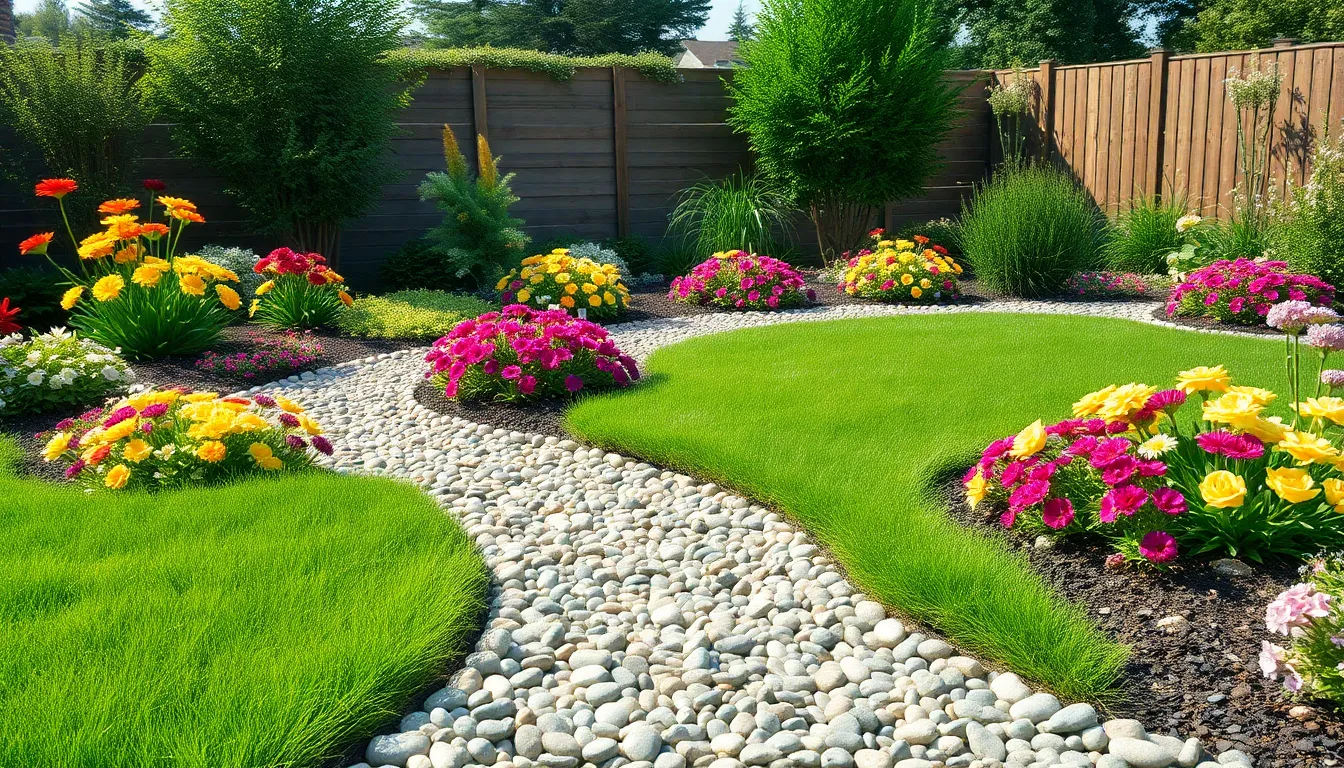
Pebble borders and edging create stunning focal points that frame your garden features with natural elegance. These decorative elements work perfectly to define spaces while adding texture and visual interest to your industry design.
Frame Flower Beds With Smooth Stones
Frame flower beds with pebbles to create a beautiful backdrop that showcases your blooms and foliage. This design approach helps retain soil moisture naturally while discouraging weeds from taking root in your planting areas.
Outline larger flower beds using substantial stones or timber borders, then fill the gaps between plants with fine pebbles for a polished look. We recommend using pebbles as a mulch alternative since they improve drainage around plant roots and prevent water from pooling.
Create visual depth by layering different sized stones, starting with larger specimens at the border and transitioning to smaller pebbles closer to plant stems. This technique draws the eye inward toward your featured plants while maintaining a clean, organized appearance.
Create Defined Lawn Boundaries
Establish clear lawn edges using pebble borders to create a clean and organized transition between grass and garden beds. These natural boundaries prevent weeds from encroaching onto your lawn while eliminating the need for frequent edge trimming.
Install pebble strips along curved lawn areas where traditional edging materials might create awkward angles or gaps. The flexible nature of loose stones allows you to follow any contour while maintaining consistent coverage.
Select uniform pebble sizes between 1 to 2 inches for lawn edging to create a professional appearance that won’t interfere with mowing equipment. This sizing also provides enough visual weight to clearly define the boundary without overwhelming nearby plantings.
Add Contrast With Mixed Pebble Colors
Combine contrasting pebble colors to create dramatic visual impact in minimalist or modern garden designs. Dark gray or black pebbles make vibrant flowers stand out dramatically, while white or tan varieties create a Mediterranean atmosphere with succulents or rosemary.
Design geometric patterns using different pebble sizes and colors to add unique artistic elements to your borders. Play with color arrangements to create soft gradients that transition naturally between different garden zones.
Mix complementary tones rather than competing colors for the most sophisticated results. Earth tones like browns, tans, and grays work together harmoniously, while cooler blues and grays pair beautifully with silver or white accent stones.
Design Beautiful Water Features Using Garden Pebbles
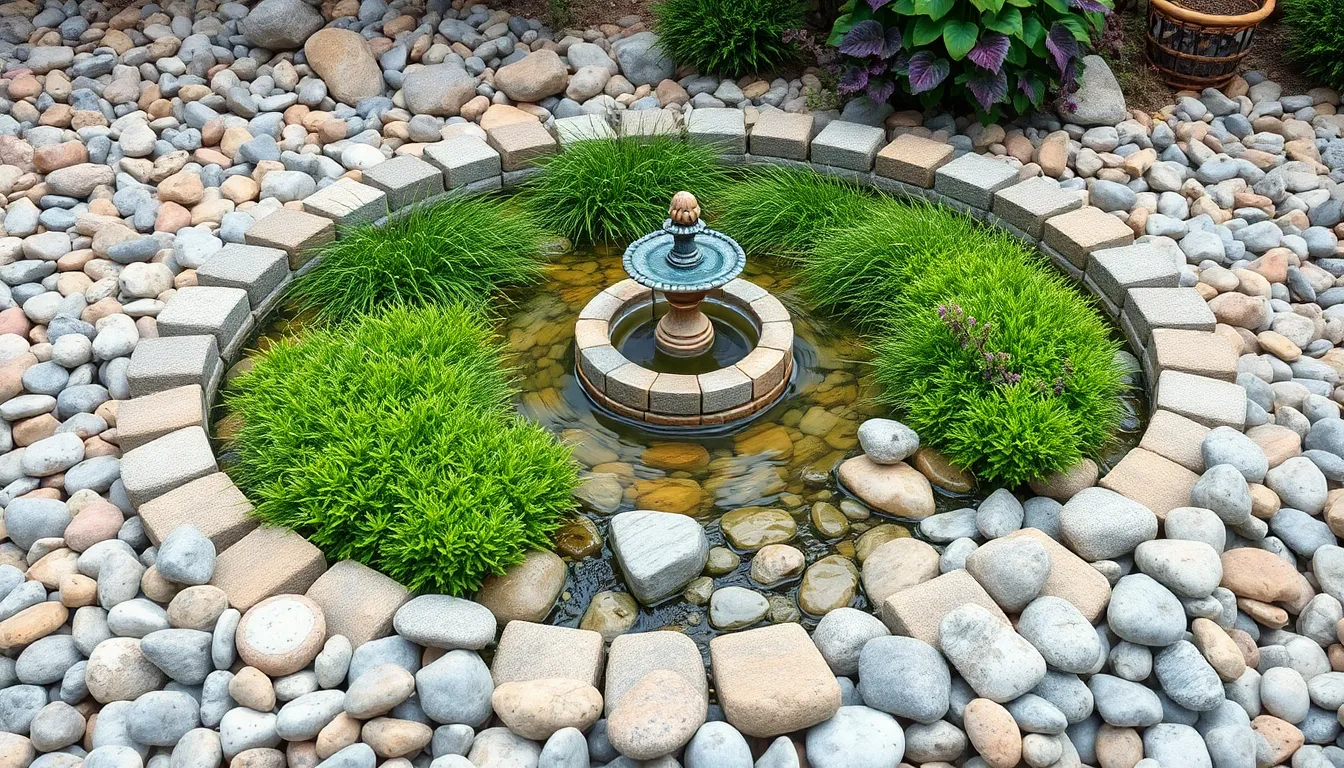
Water features transform ordinary gardens into tranquil retreats, and pebbles provide the perfect natural element to enhance these installations. We’ll explore three stunning approaches that combine flowing water with decorative stones to create captivating focal points.
Construct Pebble-Lined Fountains
Pebble-lined fountains create visually appealing centerpieces by incorporating natural stones around the water feature. We recommend using water-resistant cement or mortar to secure pebbles around the fountain base, ensuring long-lasting durability against constant moisture exposure.
Materials you’ll need include varying sizes of pebbles, a reliable fountain pump, and an appropriate water reservoir. Select stones ranging from small river rocks to larger decorative pebbles for visual texture and depth.
Design considerations involve creating mosaic effects using pebbles of different colors around the fountain perimeter. The flowing water produces enhanced soothing sounds as it cascades through the arranged stones, amplifying the relaxing atmosphere throughout your garden space.
Build Natural-Looking Stream Beds
Stream bed construction requires pebbles, small rocks, and access to a shallow water source for authentic appearance. We suggest arranging stones in winding patterns that mimic natural water flow, avoiding straight lines that appear artificial.
Installation techniques involve placing larger rocks strategically to direct water movement while filling gaps with smaller pebbles. Create gentle curves and varying depths to simulate how streams naturally carve through landscapes over time.
Maintenance advantages include easy cleaning and excellent drainage properties that prevent stagnant water issues. The pebble arrangement allows for natural filtration while creating habitats for beneficial insects and small wildlife.
Create Zen-Inspired Water Gardens
Zen water gardens incorporate pebbles surrounding central water features like fountains or small ponds for balanced, serene environments. We recommend adding complementary plants such as creeping juniper or purple flag to enhance the lush, meditative atmosphere.
Design elements feature square or circular fountains positioned centrally within pebble arrangements for optimal visual harmony. The combination creates peaceful spaces perfect for reflection and relaxation.
Color coordination involves selecting neutral-toned pebbles that complement surrounding vegetation and architectural elements. Arrange stones in concentric circles or geometric patterns radiating from the water feature to reinforce the zen aesthetic principles.
Establish Low-Maintenance Ground Cover Areas
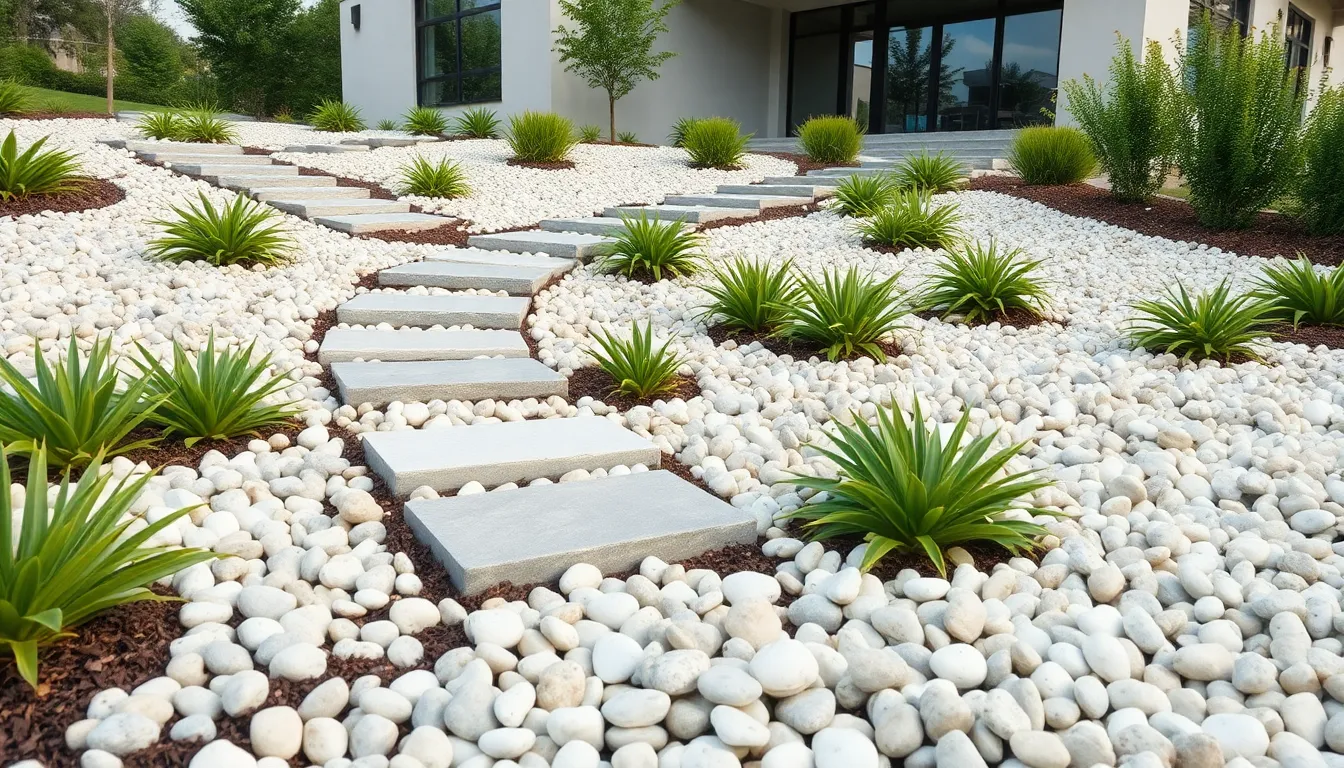
Pebbles offer an exceptional alternative to traditional grass, creating stunning ground cover that requires minimal upkeep throughout the year. We can dramatically reduce our garden maintenance while achieving professional landscaping results.
Replace Grass With Pebble Landscaping
Transform high traffic areas where grass struggles to survive by installing durable pebble ground cover. Busy homeowners benefit significantly from this approach since pebbles eliminate the need for frequent watering, mowing, and fertilizing that traditional lawns demand.
Choose pale colored pebbles for their clean, minimalist appearance that complements modern garden designs. Various pebble colors allow us to create custom looks that match our home’s exterior and existing industry features.
Install pebble landscaping in areas where grass doesn’t grow well due to shade, poor soil conditions, or heavy foot traffic. This solution provides immediate visual appeal while solving persistent lawn problems that cost time and money to address.
Fill Gaps Between Pavers
Place pebbles strategically between pavers and stepping stones to create professional looking pathways and patios. This technique prevents weeds from establishing roots while improving drainage around high use areas.
Select appropriately sized stones that fit comfortably within paver gaps without creating tripping hazards. Smaller pebbles work best for narrow joints, while larger stones suit wider spacing between pavers.
Enhance decorative appeal by choosing pebble colors that complement your paver materials and surrounding industry elements. Contrasting colors create bold visual interest, while matching tones provide subtle elegance.
Cover Sloped Areas for Erosion Control
Prevent soil erosion on garden slopes by installing pebble ground cover that holds soil in place during heavy rainfall. Sloped areas benefit from this stable solution that doesn’t require replanting after storm damage.
Create dry creek beds using pebbles to direct water away from areas prone to pooling and foundation damage. This functional design element adds natural beauty while solving drainage problems effectively.
Establish permanent coverage on steep grades where traditional plantings struggle to take root or require frequent replacement. Pebbles provide immediate erosion protection that lasts for years without maintenance or replacement costs.
Craft Artistic Focal Points and Garden Accents
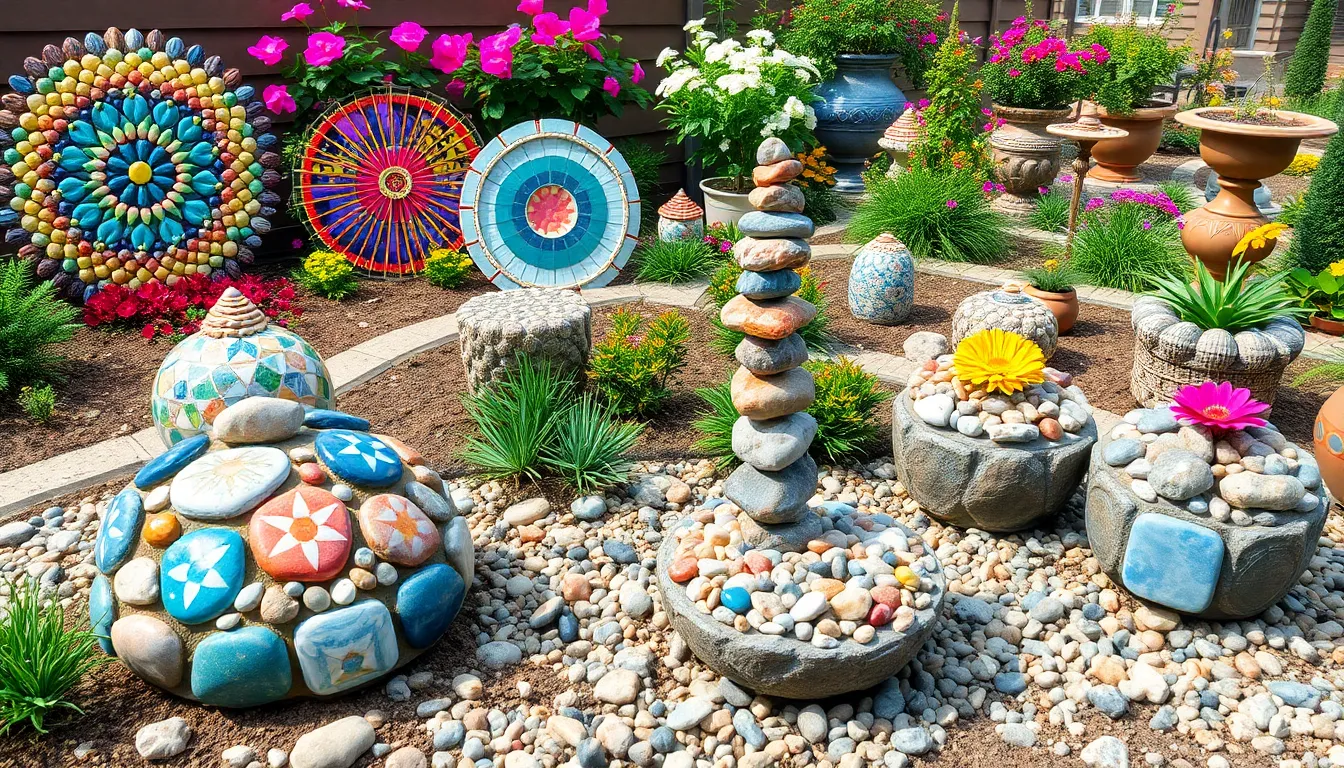
Garden pebbles transform into stunning artistic elements that draw the eye and create memorable gathering spaces. We’ll explore three distinctive approaches to elevate your outdoor design beyond basic pathways and borders.
Arrange Pebble Mosaics and Patterns
Geometric designs showcase the versatility of pebbles when we combine different colors and sizes in intricate patterns. These decorative elements add sophisticated visual appeal to garden pathways and borders while creating conversation pieces that reflect our personal style.
Create spirals and waves using nature-inspired designs that bring symbolic meaning to our outdoor spaces. River rocks in varying shades work beautifully for these flowing patterns, with larger stones anchoring the design and smaller pebbles filling detailed areas.
Select contrasting colors like white quartz pebbles against dark slate chips to make patterns pop dramatically. This approach works especially well in 3-foot by 3-foot sections where we can fully appreciate the intricate details without overwhelming the space.
Plan geometric patterns by sketching designs on paper first, then transferring measurements to the garden area. We recommend starting with simple chevron or diamond patterns before advancing to more complex Celtic knots or mandala designs.
Build Rock Cairns and Sculptures
Cairn gardens establish meditative focal points that invite contemplation and create Zen-like atmospheres throughout our industry. These balanced stone structures serve as natural sculptures while requiring minimal maintenance once properly positioned.
Stack pebbles and rocks in graduated sizes, starting with the largest stones as foundations and tapering to smaller pebbles at the top. This technique creates stable structures that withstand weather while adding vertical interest to flat garden areas.
Position cairns strategically near seating areas or along pathways where they’ll serve as wayfinding markers and conversation starters. Multiple cairns of varying heights work together to create rhythmic focal points that guide visitors through our garden journey.
Enhance larger rock sculptures by surrounding their bases with colorful pebbles that add texture and visual weight. This technique anchors substantial pieces while creating smooth transitions between hardscape elements and planted areas.
Create Decorative Planters
Pebble topped planters improve drainage while adding decorative elements that complement our plant selections perfectly. This practical approach prevents waterlogged soil conditions that damage root systems while creating polished, professional appearances.
Fill the top layer of containers with smooth river pebbles to retain soil moisture and suppress weed growth naturally. We recommend using pebbles between half an inch to one inch in diameter for optimal coverage without overwhelming smaller plants.
Embed pebbles into planter sides and bottoms for unique artistic touches that transform ordinary containers into custom garden art. Terra cotta pots work especially well for this technique, as their porous surfaces accept adhesive bonding materials effectively.
Design fire pit areas using pebbles as heat resistant bases that create warm, cozy gathering spaces under pergolas or gazebos. Combine different pebble sizes and colors in concentric circles around the fire ring to establish clear safety zones while improving the overall aesthetic appeal.
Enhance Drainage Solutions Throughout Your Garden
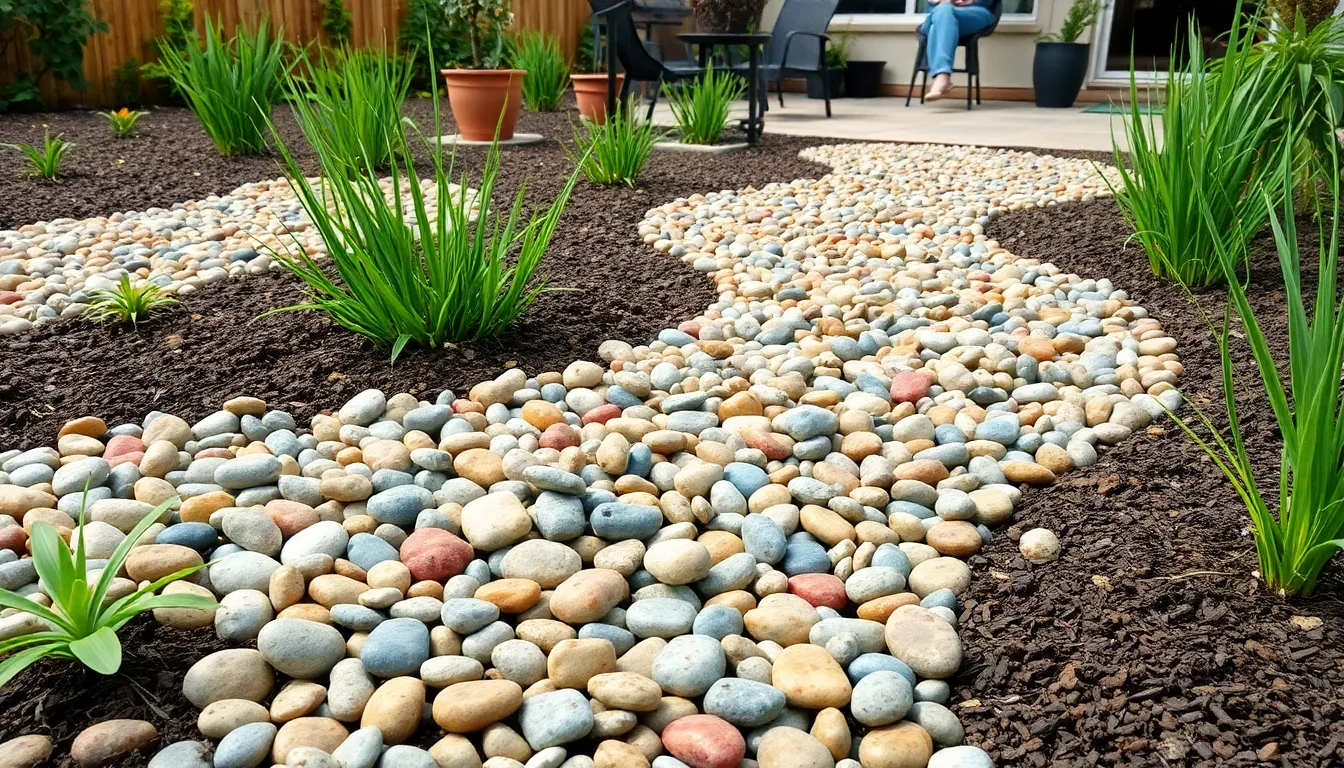
Pebbles create natural air pockets and pathways in soil that allow water to filter through easily while reducing surface pooling. We’ll show you how strategic pebble placement transforms problem areas into well-draining garden zones that protect your plants and structures.
Improve Soil Drainage Around Plants
Spreading a layer of pea gravel around plants creates excellent drainage while maintaining soil permeability. Pea gravel’s rounded shape resists compaction better than angular stones, making it our top choice for protecting plant root zones from waterlogged conditions.
Layering pebbles at the base of raised beds establishes proper drainage before adding topsoil. This foundation prevents water from accumulating around plant roots, which can lead to root rot in susceptible species like lavender, rosemary, and succulents.
Creating pebble mulch across garden beds serves dual purposes by improving drainage and deterring soil erosion. The stones allow air circulation around plant stems while helping excess water drain away from sensitive root systems during heavy rainfall periods.
Direct Water Flow Away From Structures
Installing pebble-filled channels along patios and walkways guides runoff safely away from hardscaping elements. We recommend lining these drainage channels with geotextile fabric to prevent soil mixing while maintaining optimal water flow capacity.
Constructing French drains with pebbles around building foundations protects structures from water-related damage. The pebbles create permeable barriers that intercept groundwater and direct it away from basement walls and foundation footings.
Positioning strategic pebble strips between different hardscape elements creates natural water diversion systems. These strips channel rainwater toward designated drainage areas rather than allowing it to pool against vulnerable surfaces like decks or retaining walls.
Prevent Pooling in Problem Areas
Identifying low-lying areas where water naturally collects allows us to target drainage improvements effectively. We fill these problem zones with thick layers of drainage stones or pebbles to increase surface permeability and eliminate standing water issues.
Addressing compacted soil areas with pebble amendments breaks up dense clay and improves water infiltration rates. The stones create permanent pathways for water movement, preventing the formation of impermeable surfaces that contribute to pooling problems.
Establishing pebble deposits in natural depressions protects surrounding soil from erosion during storm events. These strategic placements act as mini retention basins that slow water flow and allow gradual soil absorption rather than sudden runoff that can damage nearby plantings.
Add Texture and Visual Interest to Plant Displays
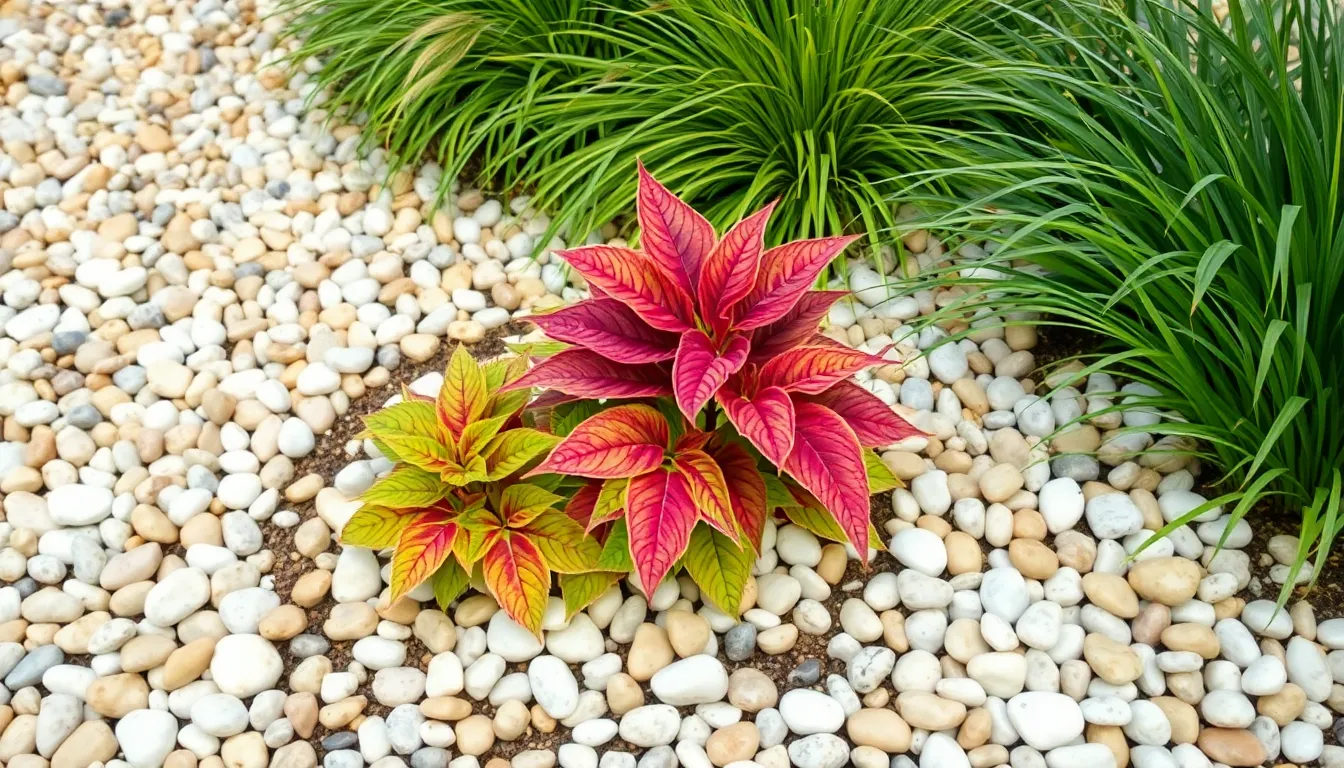
Pebbles transform ordinary flower beds into ever-changing garden features by introducing varied textures and colors that complement your existing plantings. We can arrange different sizes and hues of stones around plants to create visual contrast with foliage and blooms, making our displays more captivating and sophisticated.
Mulch Around Trees and Shrubs
Decorative stones serve as an excellent low maintenance alternative to traditional organic mulches around trees and shrubs. We find this approach particularly effective because pebbles help retain soil moisture while suppressing weeds and improving drainage naturally. Mediterranean style gardens and minimalist designs benefit especially from this clean, modern mulching technique that eliminates the need for annual mulch replacement.
Stone mulch provides long lasting coverage that won’t decompose or blow away during storms. We recommend using river rock or smooth pebbles in neutral tones like tan, gray, or white to complement most plant varieties without overwhelming the natural beauty of bark and foliage.
Highlight Specimen Plants
Creating circular borders or defined areas of pebbles around special plants draws immediate attention to our garden’s star performers. We can use this focusing technique to showcase unique specimens like Japanese maples, ornamental grasses, or prized roses by setting them apart from surrounding vegetation.
Light colored stones work exceptionally well for highlighting plants with dark foliage, while darker pebbles create stunning contrast beneath plants with silver or variegated leaves. We suggest using stones that are proportional to the plant size, with larger specimens requiring more substantial pebble borders to maintain visual balance.
Create Contrast in Monochromatic Gardens
Monochromatic garden designs gain depth and visual interest through strategic pebble placement that breaks up large areas of uniform color. We can introduce white, beige, or black stones to create striking contrasts against predominantly green landscapes or single color plant schemes.
Dark charcoal pebbles provide dramatic contrast in gardens dominated by light colored plants or pale hardscaping materials. Conversely, white or cream stones brighten spaces filled with deep green foliage or dark mulched areas, creating the visual separation needed to prevent monotonous appearances in our thoughtfully designed spaces.
Conclusion
We’ve explored countless ways pebbles can revolutionize your outdoor space from simple pathways to stunning water features. These versatile stones offer endless possibilities for creating low-maintenance landscapes that look professionally designed.
The beauty of garden pebbles lies in their adaptability – they work equally well for practical drainage answers and artistic focal points. Whether you’re working with a tight budget or planning an extensive renovation we’ve shown you how to maximize impact with minimal effort.
Your garden transformation starts with choosing the right stones for your exact needs and style preferences. With these creative ideas in hand you’re ready to build the outdoor sanctuary you’ve always envisioned.
Frequently Asked Questions
What are the main benefits of using garden pebbles in landscaping?
Garden pebbles offer versatility, low maintenance, and aesthetic appeal. They help address problem areas, create beautiful pathways, improve drainage, suppress weeds, retain soil moisture, and require no watering, mowing, or fertilizing. They’re cost-effective and can transform any outdoor space with minimal effort while providing long-lasting results.
What size pebbles work best for garden walkways?
River rocks between 1 to 3 inches in diameter are ideal for walkways. This size provides comfort for walking while creating visual impact. Smaller pea gravel works well for filling gaps between stepping stones, while larger stones can serve as borders to maintain defined pathway edges.
How do pebbles help with garden drainage?
Pebbles create natural air pockets and pathways in soil, allowing water to filter through easily and preventing surface pooling. They’re excellent for French drains, raised bed bases, and channels that direct water flow away from structures, making them essential for managing water in problematic areas.
Can pebbles replace traditional mulch around plants?
Yes, decorative stones serve as an excellent low-maintenance alternative to organic mulches. They retain moisture, suppress weeds, don’t decompose, and provide long-lasting coverage around trees and shrubs. Unlike organic mulch, pebbles don’t need regular replacement and offer better drainage while maintaining aesthetic appeal.
What’s the best way to create curved garden paths with pebbles?
Plan curved paths to follow natural landscape contours for organic flow. Use a garden hose to mark the desired curve, then excavate properly for drainage. Install sturdy borders to maintain the curved shape, and fill with appropriately sized pebbles. Combine with stepping stones for added visual interest and functionality.
How do pebbles help control weeds in garden beds?
Pebbles act as a physical barrier that suppresses weed growth by blocking sunlight from reaching weed seeds. When properly installed over landscape fabric, they create an effective, long-term weed control solution that’s more permanent than organic mulches and requires minimal maintenance.
What colors and patterns work best for pebble landscaping?
Mix complementary colors for visual contrast and interest. Use geometric patterns for formal designs or natural arrangements for organic appeal. Consider the existing landscape colors when selecting pebbles. Neutral tones like gray and beige are versatile, while colored stones can create striking accents and focal points.
Are pebbles suitable for high-traffic garden areas?
Absolutely. Pebbles are perfect for high-traffic zones where grass struggles to survive. They provide durable, attractive ground cover that withstands foot traffic without wearing down. They’re ideal for areas around patios, between pavers, and in spaces that receive heavy use while maintaining their appearance.

